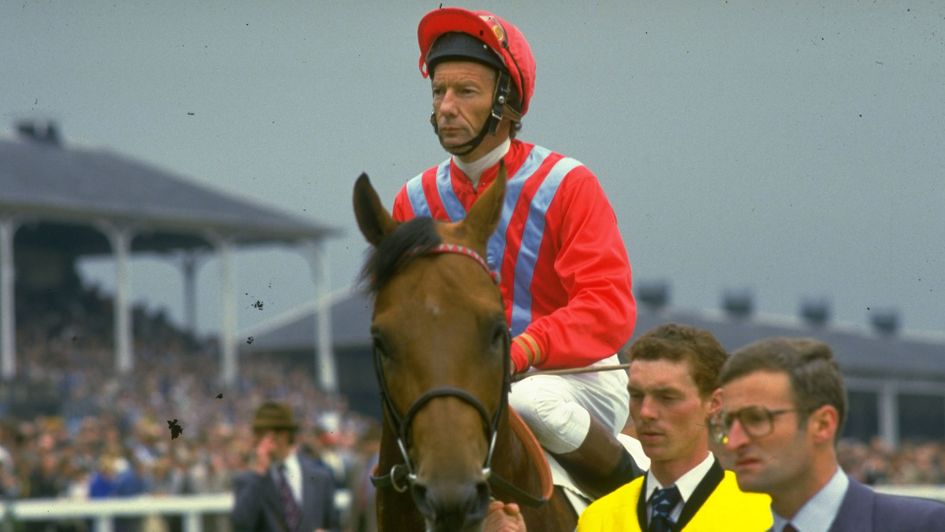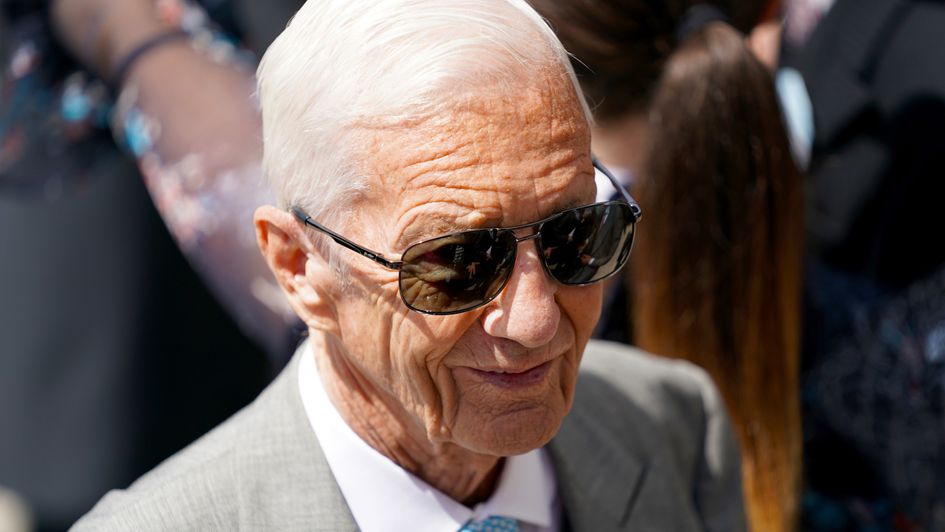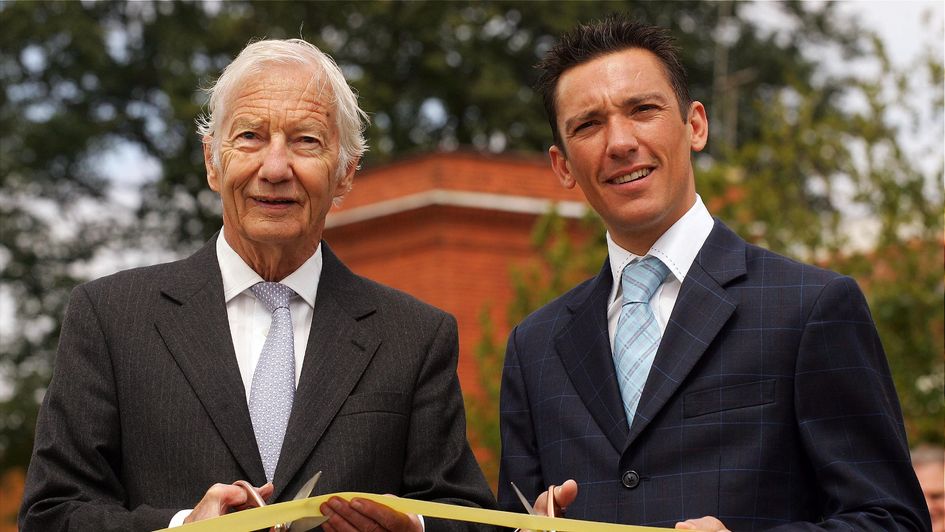Read an extract of Commanche Run's essay from Racehorses of 1984. His St Leger success gave Piggott a remarkable and record-breaking 28th British classic.
Fame in the sporting world is brutally ephemeral. From all but the immediate past the average racing man, for example, can probably identify no more than a score of jockeys and probably no more than half that number of trainers. Ask even a professional to name the jockeys that have won the championship more times than Lester Piggott and it is unlikely he will be unable to give the answer immediately. Only in rare cases is sporting fame powerful enough to endure. Grace and Bradman are examples from cricket, Vardon and Jones from golf and Archer and Richards from horse racing. The name of Piggott seems certain to endure alongside those of the last two after he retires.
As forty-nine-year-old Piggott nears the end of an illustrious career in the saddle his position among the all-time greats can hardly be questioned. Only Gordon Richards has ridden more winners in Britain - Richards' record of 4,870 is out of Piggott's reach - and only Richards, Fordham, Flatman and Archer have bettered Piggott's achievement of eleven jockeys' championships. By common consent, Piggott has been the outstanding British flat-race jockey for the past quarter of a century. His superlative big-race record - he passed Frank Buckle's number of accredited classic victories when winning the Holsten Pils St Leger in the latest season - contains any number of unforgettable performances, his Derby-winning efforts on Roberto and The Minstrel springing instantly to mind. As we have said before, racing will be very much the poorer when this brilliant, dedicated and most knowledgeable rider decides to retire.
The surprise announcement, a few days before the St Leger, that the favourite Commanche Run was to be ridden by Piggott, replacing the colt's regular rider, caused a measure of controversy, but racing's followers seemed unusually united on the day in hoping that Piggott and Commanche Run would succeed at Doncaster.
Buckle's record, unchallenged in modern times until Piggott came along, had stood since the early part of the nineteenth century. Seasonal records of jockeys' winners weren't published in Buckle's day but it is known that he rode twenty-seven classic winners between 1792 and 1827. The nineteenth century writer Henry Hall Dixon, writing under the pseudonym 'The Druid', records that Buckle was a 'faultless build for horseback, and forty years of incessant practice had combined to make him perfection'. For about half of Buckle's long career neither of the Newmarket classics existed. Some of the early records of the Two Thousand and One Thousand Guineas are sketchy and there is now speculation that the winning jockey in the 1819 and 1825 One Thousand Guineas - shown as 'unknown' in the history books - might have been Buckle, since both winners, Catgut and Tontine, were owned by the Duke of Grafton, for whom Buckle usually rode.
No proof has yet been unearthed, however, and Buckle's classic record, honoured by time and custom, seems almost certain to be left as it is. Interesting, neither the Two Thousand Guineas nor the One Thousand had the status of the other classics in Buckle's day, as is illustrated by the fact that when he sent a whip to become a challenge prize in Germany, in 1826, Buckle made no specific mention of his victories in the Newmarket classics, adding by way of commentary that he had 'won five Derbies, two St Legers, nine Oaks and nearly all the good things at Newmarket'.
With nine victories in the Derby, seven in the St Leger and five in the Oaks already in his record, Piggott began the latest season requiring one more classic victory to equal Buckle's total and he achieved that on Circus Plume in the Gold Seal Oaks, having failed to reach the frame in the first three British classics. Piggott's search for a good St Leger mount ended when he secured the ride on Commanche Run, who had been installed as the ante-post favourite for the race as early as July after a sparkling display in the Gordon Stakes at Goodwood, ridden by Piggott standing in for stable jockey McHargue who was was under suspension. The very experienced McHargue, who once rode four hundred and five winners in a racing year in North America, became the butt of some criticism in Britain for his style of riding but there was general surprise when he was stood down in favour of Piggott at Doncaster, having partnered Commanche Run to a runaway success in the March Stakes at Goodwood on the colt's last appearance before the St Leger.
Not for the first time Piggott was accused of grabbing a big-race ride at the expense of a colleague who deserved a better fate. The decision to substitute McHargue was reportedly taken at the insistence of Commanche Run's owner. 'There's only one St Leger and only one Lester', his response when asked about the decision, served to emphasise the harsh reality for Piggott's contemporaries: there is no better jockey for the big occasion. Ironically, on the day that Piggott's engagement was announced, Commanche Run's appearance in the St Leger was thrown into doubt when he grazed his knees in a mishap at home. Thankfully, Commanche Run was able to complete his intended preparation for Doncaster although his trainer did take the precaution of having him led out regularly, day and night, to minimise the risk of swelling.
This break in his normal routine may partly account for Commanche Run's breaking into a sweat and appearing very much on edge in the St Leger preliminaries: both his appearance and behaviour were in sharp contrast to his last two appearances at Goodwood where he had looked in superb shape. By contrast, Commanche Run's chief rival at Doncaster, the Queen's Vase and Geoffrey Freer Stakes winner Baynoun, couldn't have been more impressive in appearance. At Talaq and Alphabatim, fourth and fifth at Epsom and the only Derby runners to contest the St Leger, also looked particularly well, as did the fast-improving Tote-Ebor handicap winner Crazy.
Sponsorship of the St Leger, Britain's oldest classic, by the brewers Holsten resulted in a record first prize of £110,700, the first time the winner's share had topped £100,000. But, judged on the credentials of the runners, the St Leger field was a disappointing one. Of the eleven only At Talaq had won a Group 1 pattern race during the season and only four of the rest - Commanche Run, Baynoun, Alphabatim and the French-trained Mont Basile - had a pattern-race victory to their name. The efforts of the Doncaster executive to restore the prestige of the St Leger, relative in particular to the Derby, received a further blow in 1984 with the inauguration of the Phoenix Champion Stakes (first prize £207,060), run over a mile and a quarter at Phoenix Park seven days before the St Leger. What chance now of the St Leger regaining its erstwhile place as the automatic target for the Derby winner?
The St Leger also now faces opposition from Germany's most valuable event, the mile-and-a-half Group 1 Preis Von Europa at Cologne, which has been brought forward into September from its traditional date, a week after the Prix de l'Arc, and it seems likely to entice St Leger types away from Doncaster - as, for example, it did in the latest season when Gold And Ivory, runner-up in the Great Voltigeur, a traditional leading St Leger trial, ran in Germany in preference to tackling the St Leger. St Leger-placed Glint of Gold, Diamond Shoal and Esprit du Nord are among those who went on to tackle the Preis Von Europa in the three previous seasons after running at Doncaster.
The latest St Leger was rescued from anti-climax by anticipation of racing history being made and by the race itself, which proved to be a crackerjack! Commanche Run and Baynoun provided one of the most thrilling finishes in the history of the race. Alphabatim's pacemaker Liberate ensured a strong pace as far as the entrance to the final straight where Commanche Run, who had been on Liberate's heels from the start, took over, at first maintaining the tempo and then, from three furlongs out, stepping it up to his top pace. At the two-furlong marker Commanche Run was being pressed closely by Baynoun and Shergar's half-brother Shernazar, with Alphabatim and Crazy not far behind. Commanche Run kept on, under pressure, and entering the final furlong had taken the measure of all except the equally strongly-ridden Baynoun who was putting up admirably stiff resistance.
Commanche Run stayed narrowly ahead throughout the final furlong to get the better of a full-blooded tussle by a neck - first and second could not have run more gamely - with Alphabatim a length and a half away third, just ahead of Crazy and Shernazar; there was a twelve-length gap to sixth-placed Mont Basile. After the race it was widely held that the decision to engage Piggott had been justified by the result. Commanche Run's trainer, however, expressed the view that Commanche Run would also have won with McHargue up. 'The horse usually does the winning' he said, and surely no racing man of good judgement could minimise Commanche Run's contribution to this particular victory. He gave one of the most courageous performances seen all season and, in our view, didn't get nearly enough credit for it at the time.











